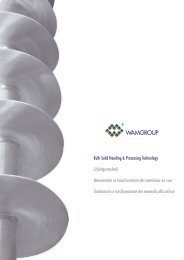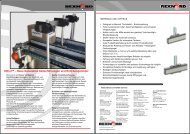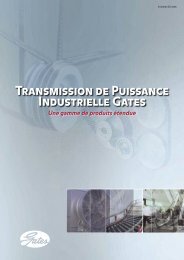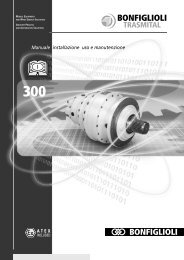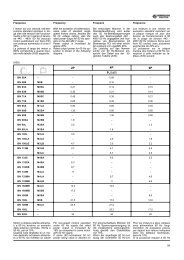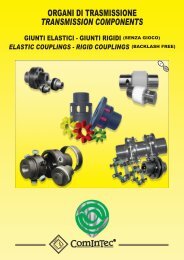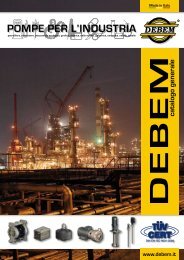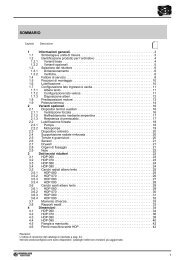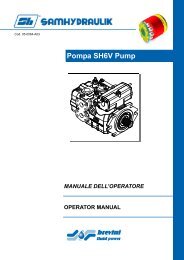BN 160M...BN 200 - Tecnica Industriale S.r.l.
BN 160M...BN 200 - Tecnica Industriale S.r.l.
BN 160M...BN 200 - Tecnica Industriale S.r.l.
Create successful ePaper yourself
Turn your PDF publications into a flip-book with our unique Google optimized e-Paper software.
Rimuovere le eventuali protezioni<br />
in plastica presenti sugli alberi seguendo<br />
le norme di sicurezza e<br />
prevenzione in vigore nel paese del<br />
destinatario.<br />
Rimuovere eventuali protettivi di<br />
protezione antiossidanti per mezzo<br />
di solventi seguendo le norme in vigore<br />
nel paese del destinatario.<br />
Evitare che il solvente venga a<br />
contatto con il labbro degli anelli<br />
di tenuta.<br />
Remove any plastic guards from<br />
the shafts according to safety regulations<br />
in customer's country.<br />
Remove any protective coatings<br />
with solvents according to safety<br />
regulations in customer's country.<br />
Do not let the solvent be in touch<br />
with oilseal lips.<br />
Eventuell vorhandenen Plastikschutz<br />
von den Wellen entfernen,<br />
unter Einhaltung der Sicherheits<br />
und Varhütungsrichtlinien gemaß<br />
des Gesetzes.<br />
Anhaftende Schutzschichten mit<br />
einem Lösemittel entfernen.<br />
Es muß unbedingt vermieden<br />
werden, daß das Lösemittel mit<br />
den Lippen der Dichtungsringe<br />
in Kontakt kommt.<br />
Enlever les éventuelles protections<br />
en plastique présentes sur les arbres<br />
suivant les normes de securité<br />
et prévention en vigueur dans le<br />
pays du destinataire.<br />
Enlever les éventuelles produits de<br />
protection antioxidants au moyen<br />
de solvants suivant les normes en<br />
vigueur dans le pays du destinataire<br />
Le solvant ne doit pas entrer en<br />
contact avec la lèvre des bagues<br />
d'étanchéité.<br />
Assicurarsi che il motore sia ben<br />
ventilato, non vi siano impedimenti<br />
alla libera circolazione dell'aria e in<br />
generale, che non insorgano situazioni<br />
che compromettano il regolare<br />
smaltimento del calore.<br />
L'installazione dovrà inoltre consentire<br />
I'esecuzione della manutenzione<br />
ordinaria del motore e, se<br />
previsto, del freno.<br />
Make sure that the motor is<br />
well-ventilated, that there is nothing<br />
to block the free circulation of<br />
air, and that no situation will arise<br />
that could block the regular<br />
dissipation of heating.<br />
The installation must also allow the<br />
ordinary maintenance on the motor<br />
and, if provided, of the brake.<br />
Sicherstellen, daß die Lüftung des<br />
Motors gut funktioniert und daß die<br />
Luft frei strömen kann. Ganz allgemein<br />
darf es nicht zu Situationen<br />
kommen, die die normale Abkühlung<br />
verhindern.<br />
Die Installation muß zudem so erfolgen,<br />
daß die normalen Wartungsarbeiten<br />
des Motors und,<br />
wenn vorgesehen, der Bremse<br />
ohne Behinderung vorgenommen<br />
werden können.<br />
S'assurer que le moteur est bien<br />
aéré, qu'il n'y a pas d'empêchements<br />
à la libre circulation de l'air<br />
et, en général, qu'il ne se produit<br />
pas de situations compromettant la<br />
dissipation régulière de la chaleur.<br />
L'installation devra en outre permettre<br />
l'entretien ordinaire du moteur<br />
et, s'il est prévu, du frein.<br />
Non sottoporre l'albero<br />
motore ad urti che possano<br />
danneggiare i cuscinetti.<br />
Avoid shocks on the<br />
motor shafts: this may<br />
damage the bearings.<br />
Die Motorenwelle darf<br />
keine Stöße bekommen,<br />
denn diese könnten<br />
die Lager beschädigen.<br />
Ne pas soumettre<br />
l'arbre à des chocs pouvant<br />
endommager les<br />
roulements.<br />
Nel caso di motori con montaggio<br />
verticale ed albero in basso, I'ingresso<br />
aria dovrà essere protetto da<br />
un tettuccio.<br />
Nelle installazioni all'aperto, proteggere<br />
il motore dall'irraggiamento<br />
diretto e, se possibile, dalle intemperie.<br />
Accoppiando motori elettrici con<br />
flangia IEC B5 o B14 ai riduttori, e<br />
prima di introdurre l'albero del motorenell'alberocavodelriduttorestesso,<br />
assicurarsi che la linguetta del<br />
motore sia perfettamente stabile.<br />
Spalmare su tutta la lunghezza dell'albero<br />
del motore appositi componenti<br />
(es. Loctite Antiseize 767) per<br />
prevenire fenomeni di usura superficiali,<br />
meglio conosciuti come “fretting<br />
corrosion” o “ polveri rosse”.<br />
Ogni6-12mesi è opportuno scollegare<br />
il motore dal riduttore, pulire<br />
la zona di accoppiamento albero/foro<br />
e ripristinare la protezione<br />
antiusura sopra descritta.<br />
Assicurarsi che il fissaggio del motore<br />
sulla flangia del riduttore avvenga<br />
in modo stabile per non dare<br />
luogo a vibrazioni.<br />
Nel caso che i motori debbano essere<br />
verniciati è opportuno proteggere<br />
la targa di identificazione.<br />
Nei motori flangiati il centraggio è<br />
previsto con tolleranza j6 132,<br />
h6 160.<br />
In case of motors with vertical assembly<br />
and shaft below, fan cover<br />
must be protected by a canopy.<br />
In outdoor installations, protect the<br />
motor from direct sunlight and, if<br />
possible, from inclement weather.<br />
When coupling electric motors with<br />
flange IEC B5 or B14 to gearboxes,<br />
and before inserting the motor<br />
shaft in the hollow shaft of the gearbox,<br />
make sure that the motor key<br />
is perfectly stable.<br />
Spread a suitable substance (such<br />
as Loctite Antiseize 767) over the<br />
entire length of the shaft to prevent<br />
surface wear, better known as fretting<br />
corrosion or red dust.<br />
It is a good rule to disconnect the<br />
motor from the gearbox every 6-12<br />
months, clean the shaft/hole coupling<br />
zone, and restore the above-described<br />
anti-wear conditions.<br />
Make sure that the motor is secured<br />
to the gearbox flange in a stable<br />
manner and does not cause vibrations.<br />
If the motors must be painted, it is<br />
advisable to protect the name<br />
plate.<br />
Pilot diameter on flanged motors<br />
have a j6 132, h6 160 tolerance.<br />
Falls die Motoren vertikal montiert<br />
werden und die Welle sich unten<br />
befindet, muß der Eingang durch<br />
ein Schutzdach geschützt werden.<br />
Bei Installationen im Freien muß<br />
der Motor vor direkten Sonnenstrahlen<br />
und, wenn möglich, vor<br />
Witterungseinflüssen geschützt<br />
werden.<br />
Werden Elektromotoren mit IEC<br />
B5- oder B14-Flanschen an die<br />
Getriebe angeschlossen, ist vor<br />
dem Einführen der Motorwelle in<br />
die Hohlwelle des Getriebes zu<br />
kontrollieren, ob die Feder des Motors<br />
völlig stabil ist. Auf die ganze<br />
Motorwellenlänge spezielle Produkte<br />
streichen (z.B. Loctite Antiseize<br />
767), um eine Oberflächenabnützung<br />
zu verhindern - dieses<br />
Problem ist vielleicht besser bekannt<br />
unter dem Namen “fretting<br />
corrosion” oder “roter Staub”.<br />
EAin- bis zweimal pro Jahr muß der<br />
Motor vom Getriebe entfernt und<br />
die Zone, wo sich Welle und Öffnung<br />
berühren, gereinigt werden,<br />
dann die eben beschriebene Oberflächenbehandlung<br />
wiederholen.<br />
Man kontrolliere, ob der Motor gut<br />
am Getriebeflansch fixiert ist, sodaß<br />
er nicht vibriert.<br />
Falls die Motoren lackiert werden<br />
sollen, empfehlen wir, das Typenschild<br />
zu schützen.<br />
Bei Flanschmotoren beträgt die<br />
vorgesehene Zentrierungstoleranz<br />
j6 132, h6 160.<br />
Sur les moteurs à montage vertical<br />
et avec arbre en bas, l'entrée de<br />
l'air doit être protégée par un capot<br />
de protection parapluie.<br />
Sur les installations en extérieur,<br />
protéger le moteur du rayonnement<br />
direct et, si possible, des intempéries.<br />
Pour l'accouplement de moteurs<br />
électriques aux réducteurs au<br />
moyen d'une bride IEC B5 ou B14,<br />
avant d'introduire l'arbre du moteur<br />
dans l'arbre creux du réducteur,<br />
s'assurer que la clavette du moteur<br />
soit parfaitement stable.<br />
Appliquer sur toute la longueur de<br />
l'arbre du moteur un produit prévu à<br />
cet effet (par exemple, Loctite Antiseize<br />
767), pour empêcher les phénomènes<br />
d'usure superficielle,<br />
mieux connus sous le nom de “frettingcorrosion”ou“poudresrouges”.<br />
Tous les 6-12 mois, il convient de<br />
déconnecter le moteur du réducteur,<br />
de nettoyer la zone d'accouplement<br />
arbre/trou, et d'appliquer<br />
de nouveau la protection anti-usure<br />
décrite ci- dessus.<br />
S'assurer que la fixation du moteur<br />
sur la bride du réducteur se fasse<br />
de façon stable, sans possibilité de<br />
vibrations.<br />
Si les moteurs doivent être peints,<br />
nous vous conseillons de protéger<br />
la plaque signalétique.<br />
Sur les moteurs bridés, le centrage<br />
est prévu avec une tolérance j6 <br />
132, h6 160.<br />
72



